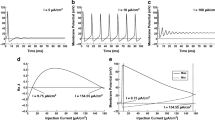Abstract
Three neuronal models of the spike initiating process were investigated with respect to their ability to show adaptation to a current step: (i) the perfect integrator model (PIM), (ii) the leaky integrator model (LIM), and (iii) the Hodgkin-Huxley (HH-) model. It was found that although each neuronal model will generate different response spike trains to a given stimulus, all responses fulfilled the criteria of a deterministic neural response (Awiszus 1988). The results show that both PIM and LIM are unable to show adaptation regardless of the choice of model parameters whereas the HH-model shows a clear rate of discharge adaptation. The reason for this adaptation lies in the fact that there are conditions for the HH-model where a step stimulus is highly effective. These conditions are investigated by means of a phase plane analysis. Consequences of these results for the explanation of neuronal adaptation and the validity of the neuronal models investigated are discussed.
Similar content being viewed by others
References
Awiszus F (1988) Continuous functions determined by spike trains of a neuron subject to stimulation. Biol Cybern 58:321–327
Bayly EJ (1968) Spectral analysis of pulse frequency modulation in the nervous system. IEEE Trans Biomed Eng 15:257–265
Boyd IA (1976) The mechanical properties of dynamic nuclear bag fibres, static nuclear bag fibres and nuclear chain fibres in isolated cat muscle spindles. Prog Brain Res 44:33–50
Fitzhugh R (1960) Thresholds and plateaus in the Hodgkin-Huxley nerve equations. J Gen Physiol 43:867–896
French AS (1984) The frequency response function and sinusoidal threshold properties of the Hodgkin-Huxley model of action potential encoding. Biol Cybern 49:169–174
Hasard B (1978) Bifurcation of periodic solutions of the Hodgkin-Huxley model for the squid giant axon. J Theor Biol 71:401–420
Hodgkin AL, Huxley AF (1952) A quantitative description of membrane current and its application to conduction and excitation in nerve. J Physiol 117:500–544
Holden AV (1976) Models of stochastic activity of neurones. Springer, Berlin Heidelberg New York
Hunt CC, Ottoson D (1975) Impulse activity and receptor potential of primary and secondary endings of isolated mammalian muscle spindles. J Physiol 252:259–281
Michaelis B, Chaplain RA (1973) The encoder mechanism of receptor neurons. Kybernetik 13:6–23
Moore JW, Ramon F (1974) On numerical integration of the Hodgkin and Huxley equations for a membrane action potential. J Theor Biol 45:249–273
Nakajima S, Onodera K (1969) Membrane properties of the stretch receptor neurones of crayfish with particular reference to mechanisms of sensory adaptation. J Physiol 200:161–185
Nemoto I, Miyazaki S, Saito M, Utsunomiya T (1975) Behavior of solutions of the Hodgkin-Huxley equations and its relation to properties of mechanoreceptors. Biophys J 15:469–479
Noble D (1966) Applications of Hodgkin-Huxley equations to excitable tissues. Physiol Rev 46:1–50
Perkel DH, Gerstein GL, Moore GP (1967) Neuronal spike trains and stochastic point processes. I. The single spike train. Biophys J 7:391–418
Scharstein H (1979) Input-output relationship of the leaky-integrator neuron model. J Math Biol 8:403–420
Stein RB, French AS, Holden AV (1972) The frequency response, coherence, and information capacity of two neuronal models. Biophys J 12:295–322
Author information
Authors and Affiliations
Rights and permissions
About this article
Cite this article
Awiszus, F. The adaptation ability of neuronal models subject to a current step stimulus. Biol. Cybern. 59, 295–302 (1988). https://doi.org/10.1007/BF00332919
Received:
Published:
Issue Date:
DOI: https://doi.org/10.1007/BF00332919




